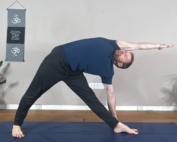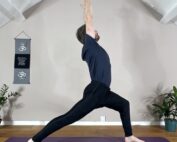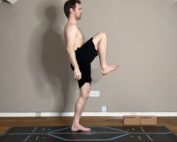
The Art of Mastering Bird of Paradise Pose to Increase Your Flexibility
Hi, My name is Dav Jones, a dedicated yoga practitioner, and yoga teacher trainer. I’m excited to be part of your journey. Today In this blog, we’ll explore the Bird of Paradise pose (Svarga Dvijasana) and its benefits. Whether you’re new to yoga or a seasoned practitioner, you’ve found the perfect spot to deepen your practice. Let’s embark on this journey together and discover the magic of the Bird of Paradise yoga pose!
What is the Bird of Paradise Pose?
The Bird of Paradise Pose, or Svarga Dvijasana, is a challenging yoga asana where you balance on one leg whilst binding the arms. This pose helps improve your stability and flexibility and increases your focus too. Practising this pose can boost your confidence and make you feel more in tune during your yoga practice. It’s a great way to bring beauty, strength and focused concentration to your yoga routine.
Birds of Paradise Pose (Svarga Dvijasana) Basics
- Sanskrit: Svarga Dvijasana
- Pronunciation: “Svar-ga Dvi-jah-sa-na”
- Meaning: Named after the strikingly beautiful Bird of Paradise, this pose is about capturing their standout beauty and grace, helping you work on better balance and posture.
Preparatory Poses
Before you try this bird of paradise yoga pose, it’s good to warm up with some preparatory poses. These poses help prepare your body by warming up the necessary muscle tissue and mobilising the necessary joints.
- Extended Triangle Pose (Utthita Trikonasana) – Stretches your legs, hips, and spine, and builds stability.
- Warrior II (Virabhadrasana II) – Strengthens your legs and opens your hips, getting them ready for balancing.
- Extended Side Angle Pose (Utthita Parsvakonasana) – Opens your hips and side body, improving flexibility.
- Bound Side Angle Pose (Baddha Parsvakonasana) – The practice of binding the arms works the flexibility of the shoulders, which is crucial for the efficacy of Bird of Paradise.
Step-by-Step Guide to Bird of Paradise Pose
Here’s a straightforward step-by-step guide to performing the Bird of Paradise Pose (Svarga Dvijasana):
1. Start in an Extended Side Angle Pose (Utthita Parsvakonasana):

- Side Angle Posture looks similar to the Warrior 2 posture. The difference being is in the position of the arms.
- This is a great preparatory pose for Bird of Paradise as it opens the hips and stretches the necessary muscle tissue.
2. Progress into Bound Side Angle Pose:

- From Side Angle Pose, now work into finding the bind with the arms as you wrap the bottom arm under the leg reaching for the top arm behind you.
- Either use a strap to find the bind, or if you have the shoulder flexibility, clasp the fingers or even take the wrist.
3. Standing-Prep for Bird of Paradise:

- Step forward with the back leg from Bound Side Angle Pose. Aim to keep the bind.
- Shift the weight into the leg that isn’t bound.
- Find a point on the floor to focus on, as you prepare to stand up for Bird of Paradise.
4. Pre-Bird of Paradise Balance:

- Slowly, start to stand keeping your attention on your fixed gaze.
- Keep grounding through the mound of the big-toe in the standing leg.
- TIP: I personally find, keeping a bend in the standing knee helps me to straighten out the top leg. Give it a try and see how it works for you.
5. Bird Of Paradise:

- Finally, we start to straighten out the top leg for Bird of Paradise.
- I find that slightly leaning back helps me to maintain more of a balance in the pose.
6. Extend and Hold:
- With your body balanced on the right leg, focus on extending your spine and opening your chest. Try to hold this position for several breaths, maintaining a steady gaze to help balance.
7. Release and repeat:
- Gently lower your left leg back into a squat, release your arms, and repeat the above steps on the other side.
Benefits of the Bird of Paradise Yoga Pose
The Bird of Paradise Pose (Svarga Dvijasana) offers a range of benefits that extend across both physical and mental aspects of well-being. Here’s how this pose can enhance your physical fitness and mental health:
Physical Benefits
- Improves Balance: Standing on one leg greatly improves your ability to maintain focus and concentration.
- Enhances Flexibility: This pose stretches the hamstrings, groin, and hips, promoting a greater range of motion and flexibility in these areas.
- Strengthens Muscles: It actively engages and strengthens the muscles of the standing leg, particularly the quadriceps and calves muscles which help to maintain posture and balance.
- Open’s Shoulders and Chest: The arm bind in this pose helps open up the shoulders and chest, which is beneficial for improving posture and alleviating tension from these areas.
Mental Benefits
- Increases Focus and Concentration: Balancing poses require a significant amount of mental focus and concentration to maintain stability, which can help improve overall cognitive functions.
- Reduces Stress: The concentration needed to hold this pose helps divert attention from daily worries and stresses, promoting a sense of inner peace and relaxation.
- Builds Confidence: Mastering a complex pose like the Bird of Paradise can provide a sense of accomplishment and boost self-esteem, encouraging further exploration and persistence in yoga and other areas of life.
Key Props for Supporting Bird of Paradise Pose
When practicing the Bird of Paradise Pose (Svarga Dvijasana), using props can be a great asset, especially for beginners or those who may not have the flexibility or balance fully developed yet. Here are some prop options and postures that can progress you towards Bird of Paradise Posture:
1. Compass Pose with a strap:

- Compass Pose is a great posture to help increase flexibility in your hips.
- This posture has a few similarities with Bird of Paradise especially in regards to the hips focus.
- The benefit of adding this posture into your practice for Bird of Paradise is that it brings an opening to the hips and also takes out the challenge of the balance allowing the practitioner to solely focus on hip flexibility.
2. Trikonasana (Triangle Pose) with a block:

- Adding the additions of yoga blocks into your practice for Bird of Paradise is a great way to ease into opening the muscle tissue around the hips.
- Trikonasana is a great preparation pose for Bird of Paradise. Apart from the bind, you can the see the position of the legs resembles a similar shape/position to the legs of Bird of Paradise.
3. Using a strap for the Bind of the Arms:

- The use of a strap can be a great asset when it comes to the binding of the arms for poses like Bound Side Angle (pictured above) or Bird of Paradise.
- If you struggle finding a bind, use a strap your shoulders will thank you for it.
Avoiding Injury in Bird of Paradise Pose
When practising this bird of paradise yoga pose, ensure proper warm-up to avoid muscle strains. Avoid the pose if you have low blood pressure, knee, or shoulder injuries. Use props for support, and don’t force the bind or the balance, as this can lead to overstretching or falls. Always listen to your body in the execution of the pose.
Final Thought
We’ve explored Bird of Paradise Pose, highlighting its steps and benefits for enhancing your yoga asana practice. If you’re interested in deepening your practice, consider joining the Dav Jones online yoga classes on Patreon. For a more tailored/specific approach to your practice, then take a look at the Dav Jones Yoga mentorship program.









